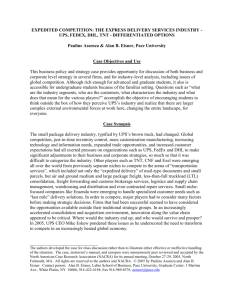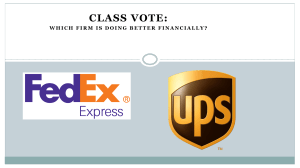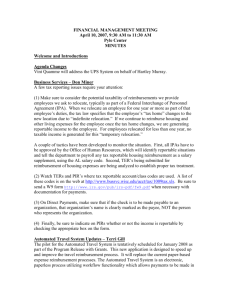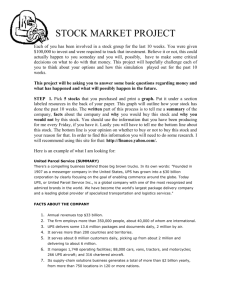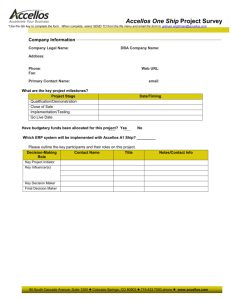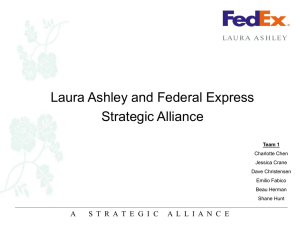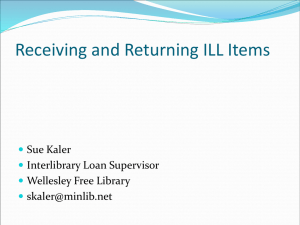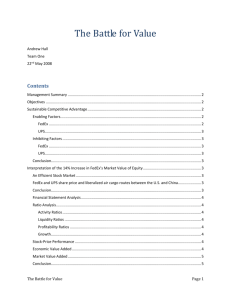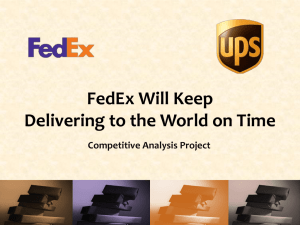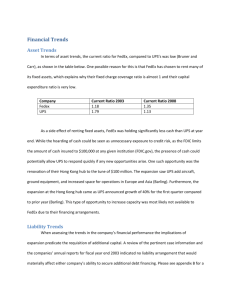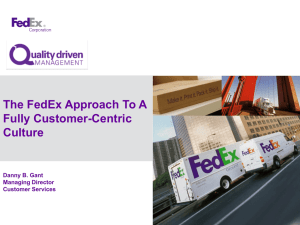AIR BORNE EXPRESS
advertisement
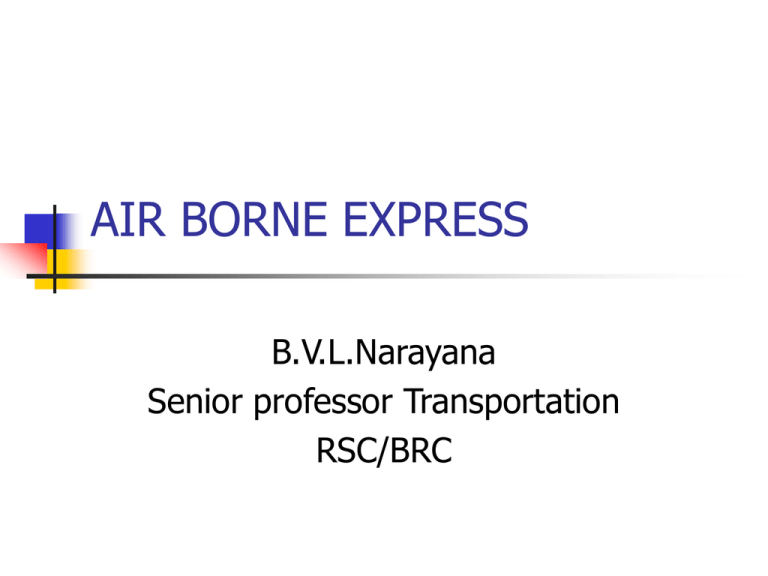
AIR BORNE EXPRESS B.V.L.Narayana Senior professor Transportation RSC/BRC Objective of class To understand and learn concepts of Value chain Trade offs Strategy Sustained competitive advantage Issues in case What is the future of Air borne express Competition from FedEx and UPS Postal services Tie up with RPS Internationalization Future growth Impact of UPS strike— doubts on single sourcing Distance based pricing Industry environment Three major players FedEx –inventor of this service Growing at 15% volume, 10%revenues Growing category of perishable items Shortening business cycles, inventory control or export, demand for services Decision to use— Urgency and price; companies –use std procedures or individuals Reliability of carrier, tracking, service, pick up Document delivery industry Segment FedEx UPS Air borne Others Premium expedited—next morning and early next morning Y Y but Marginal Y niche TNT,DHL-international Next afternoon Y Y Y TNT,DHL Regular—2nd day - Y main segment US postal—no discounts 3rd day - Y Super premium same day Y - - US postal— monopoly on first class letters - Volume of traffic 2.8 million packages 12 million 1 million Expedited share 45% 25% (1.6million) 16% (1 million) revenues 11.5 billion 22 billion 2.4 billion Revenue per package 11.5 5.2 8 Industry characteristics Express delivery service—users Individuals High volume customers– catalog retailers Financial and consulting service providers Spares, medical drugs, samples Shipment characteristics High value to weight ratio Perishable—highly time sensitive Do not depend on how they tarvel Operations in industry Basic infrastructure and activities similar Varying use of human, information and physical assets Use of IT to record, track packages Use hub and spoke for transport Air for overnight delivery; road for others Large network of customer service centers Costing and market shares Segment FedEx UPS Air borne Total market FC employees 46% -1,29, 000 64% --3,66,000 4.5% --20,700 Over heads 7% 16% 10% Depreciation 22% 5% 12% Operating expenses 22% 15% 75% Op margins 6.1% 9.1% 8% Expedited value 7.2 billion Expedited packages 2.8 million 1.6million 1million 6.4 million realization 9 7 8 7.3 Share mix With premium 87% second day, 30% volume discount Niche volume discount 16-17 billion Comparison of strategy components Characteristic FedEx UPS Air borne Historical inheritance Invented express mail industry Package delivery of departmental stores Specialist air freight services Key focus area High customer,employee focus; internal promotion, no layoffs Communications; internationalize Cost driven; shift to part time employees; internationalize Industrial customers, cost sensitive Strategic positioning Increased range of services over value chain High volumes. High operational efficiency; save on expenditure Customization to realize value; tie up with RPS Cost savings measures Customer lock in, increase realized value—increased services, transfer activity to customers Concentrate on employee satisfaction, generate better services Cost cutting, minimum required overheads—advt etc, focused sales pitch; regulate volume discounts; pricing; selective use of technology Incentivisation Linked to skill development, training output– delegated decision making, recognitions Delivery bonuses; ESOPS; life long employment;high wages Customer retention; target logistics managers; higher margin products Comparison of strategy components Characteristic FedEx UPS Air borne Control mechanisms and focus High, focus on standards, IT, Training and service delivery Customer focus, Industrial marketing, focus on key personnel and customers Extension strategies Stick to premium segment, innovate in services Shifting to high customer focus segments Getting into package delivery, RPS, give value added services Failure recovery mechanisms Increase use of recovery methods Less sensitive to time Control on sales personnel Evaluation criteria Customer satisfaction Quality of delivery , operational factors Directed customer satisfaction, costs Operational strategies Equate service delivery to customer needs, highly distributed delivery system Highly distributed delivery system, contractor performance critical Focused metropolitan deliveries, equate to customer erquirements Distance based pricing Issue of costs Fixed costs vs operational costs Contracting of services Unionization of employees New technologies FAX, E-mail, legalization of these Electronic documentation Role of postal services Value addition Delivery –time schedule guarantees Tracking of packet; information Ware housing; customs clearance; documentation Logistics consultancy Inventory management Add on for customer, packaging, labeling, pickups, e-payment etc Self servicing –customer lock in –IT based Definitions Value chain –sequence of activities required to provide a service or make a product Value is the worth perceived by the customer to have been received through the purchase of a service or product What is strategy •Competitive strategy is being different- deliberately choosing a different set of activities to deliver a unique mix of value •Strategy is creation of a unique and valuable position •Strategy is about combining activities and creating a fit between them •Strategy is creating fit among a company’s activities so as to enable it to position its product in such a way that competitive advantage is clear.
